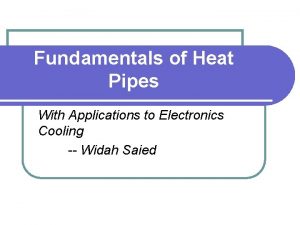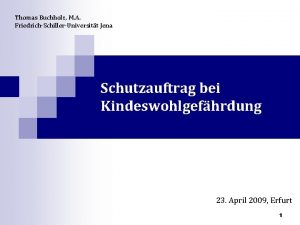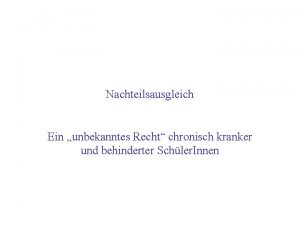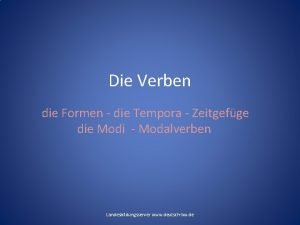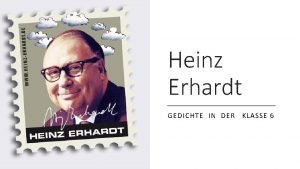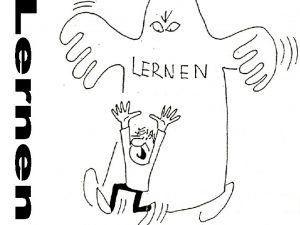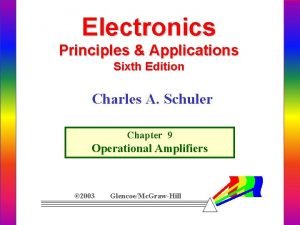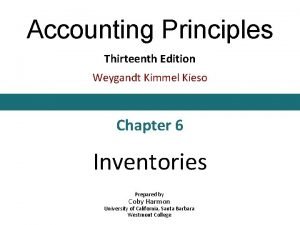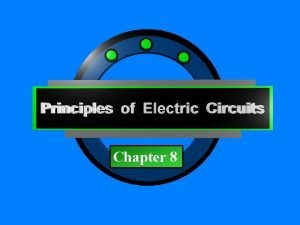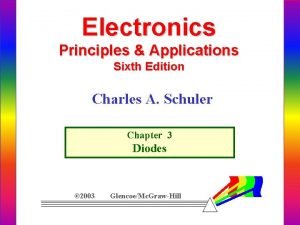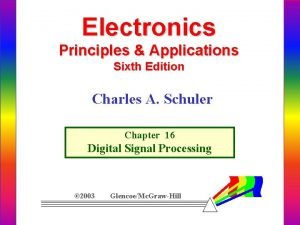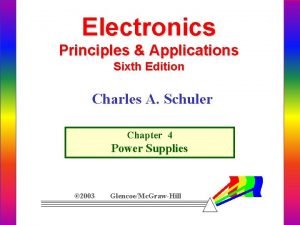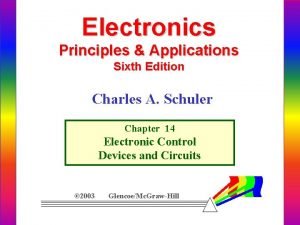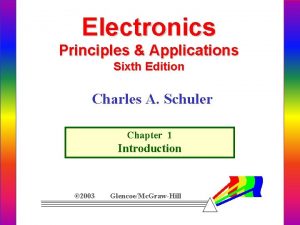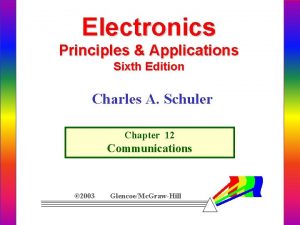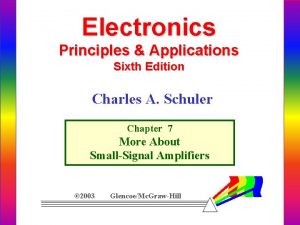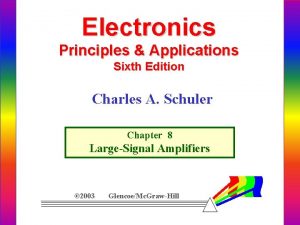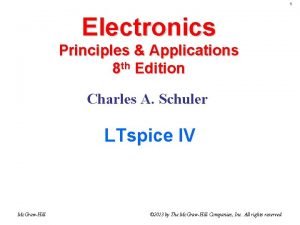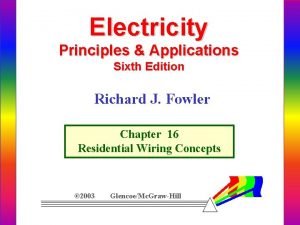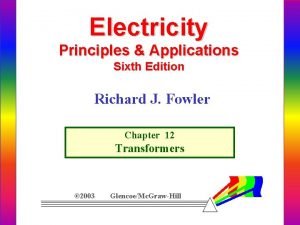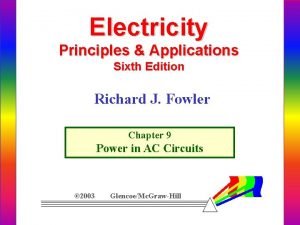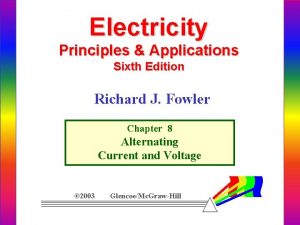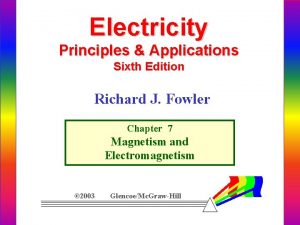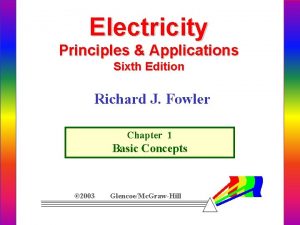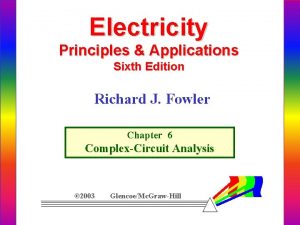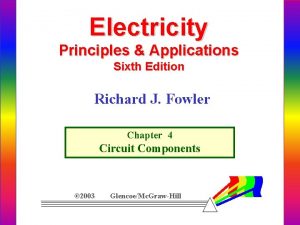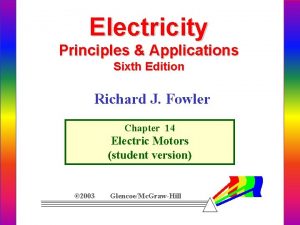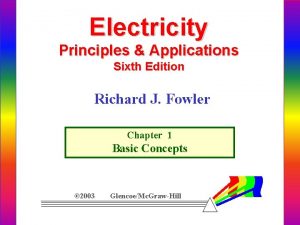Electronics Principles Applications Sixth Edition Charles A Schuler






























































- Slides: 62

Electronics Principles & Applications Sixth Edition Charles A. Schuler Chapter 9 Operational Amplifiers © 2003 Glencoe/Mc. Graw-Hill

INTRODUCTION • The Differential Amplifier • The Operational Amplifier • Determining Gain • Frequency Effects • Applications • Comparators

A differential amplifier driven at one input +VCC Inverted output B Noninverted output C E -VEE B

Both outputs are active because Q 1 drives Q 2. Q 1 serves as an emitter-follower amplifier in this mode to drive Q 2. +VCC C B Q 1 E Q 2 serves as a common-base amplifier in this mode. It’s driven at its emitter. C E Q 2 -VEE B

A differential amplifier driven at both inputs Common mode input signal +VCC Reduced output B Reduced output C E -VEE B

A differential amplifier driven at both inputs Differential mode input signal +VCC Increased output B Increased output C E -VEE B

Differential Amplifier dc Analysis IR = VEE - VBE RE E IE = IR 2 E 9 V - 0. 7 V = 2. 13 m. A = 3. 9 k. W VCC = 1. 06 m. A 4. 7 k. W IC = IE = 1. 06 m. A 10 k. W B RB +9 V RL RL C E 3. 9 k. W VEE VR = I C x RL L = 1. 06 m. A x 4. 7 k. W = 4. 98 V VCE = VCC - VRL - VE 4. 7 k. W = 9 - 4. 98 -(-0. 7) C E RE -9 V = 4. 72 V B RB 10 k. W

Differential Amplifier dc Analysis (continued) Assume b = 200 IB = IC b VB = V R = I B x RB B 1. 06 m. A = 200 = 5. 3 m. A VCC 4. 7 k. W 10 k. W RB +9 V = 53 m. V RL RL 4. 7 k. W C B = 5. 3 m. A x 10 k. W E 3. 9 k. W VEE C E RE -9 V B RB 10 k. W

Differential Amplifier ac Analysis 50 m. V (50 m. V is conservative) = 47 W = r. E = IE 1. 06 m. A RL VCC +9 V AV(CM) = RL 2 x RE AV(DIF) = 2 x r. E 4. 7 k. W RL RL 4. 7 k. W = 4. 7 k. W 2 x 3. 9 k. W = = 50 2 x 47 W C C = 0. 6 10 k. W B RB E 3. 9 k. W VEE E RE -9 V B RB 10 k. W

Differential Amplifier ac Analysis (continued) CMRR = 20 x log AV(DIF) AV(CM) VCC 4. 7 k. W 10 k. W RB +9 V RL RL 4. 7 k. W C B 50 = 20 x log = 38. 4 d. B 0. 6 E 3. 9 k. W VEE C E RE -9 V B RB 10 k. W

AV(CM) = A current source can replace RE to decrease the common mode gain. RL VCC 2 x RE Replaces this with a very high resistance value. 10 k. W 4. 7 k. W RL RL 4. 7 k. W C B RB E * C E B RB 10 k. W 2 m. A *NOTE: Arrow shows conventional current flow.

A Practical Current Source IC 9 V - 5. 1 V IZ = = 10 m. A 390 W IE = 390 W 5. 1 V - 0. 7 V 2. 2 k. W IC = IE = 2 m. A 5. 1 V 2. 2 k. W -9 V = 2 m. A

A Demonstration of Common-mode Rejection The common-mode signal cannot be seen in the output. The amplitude of the common-mode signal is almost 30 times the amplitude of the differential signal. 6. 3 V 60 Hz 212 m. V 1 k. Hz

Differential Amplifier Quiz When a diff amp is driven at one input, the number of active outputs is _____. two When a diff amp is driven at both inputs, there is high gain for a _____ signal. differential When a diff amp is driven at both inputs, there is low gain for a ______ signal. common-mode The differential gain can be found by dividing the collector load by ____. 2 r. E The common-mode gain can be found by dividing the collector load by ____. 2 RE

Op amps have two inputs Inverting input Non-inverting input Output

Op-amp Characteristics • High CMRR • Available as ICs • High input impedance • Inexpensive • High gain • Widely applied • Low output impedance • Reliable

With both inputs grounded through equal resistors, VOUT should be zero volts. +VCC VOUT -VEE Imperfections can make VOUT non-zero. The offset null terminals can be used to zero VOUT.

Dt DV 741 DV Slew rate = Dt 0. 5 V ms The output of an op amp cannot change instantaneously.

VP f > f. MAX = Slew-rate distortion Slew Rate 2 p x VP

Operational Amplifier Quiz The input stage of an op amp is a _____ amplifier. differential Op amps have two inputs: one is inverting and the other is ____. noninverting An op amp’s CMRR is a measure of its ability to reject a ____ signal. common-mode The offset null terminals can be used to zero an op amp’s _____. output The ability of an op amp output to change rapidly is given by its _____. slew rate

Op-amp Follower AV(OL) = the open loop voltage gain AV(CL) = the closed loop voltage gain This is a closed-loop circuit with a voltage gain of 1. It has a high input impedance RL and a low output impedance.

Op-amp Follower AV(OL) = 200, 000 AV(CL) = 1 The differential input approaches zero due to the high open-loop gain. Using this model, VOUT = VIN. VDIF = 0 VIN VOUT RL

Op-amp Follower AV(OL) = 200, 000 B=1 A AB +1 VIN VOUT The feedback ratio = 1 200, 000 @1 AV(CL) = (200, 000)(1) + 1 VIN VOUT RL

The closed-loop gain is increased by decreasing the feedback with a voltage divider. R 1 200, 000 AV(CL) = = 11 (200, 000)(0. 091) + 1 RF R 1 B= 100 k. W RF + R 1 10 k. W = VIN VOUT RL 10 k. W 100 k. W + 10 k. W = 0. 091

It’s possible to develop a different model for the closed loop gain by assuming VDIF = 0. R 1 VIN = VOUT x R 1 + R F RF Divide both sides by VOUT and invert: 100 k. W R 1 10 k. W VOUT VDIF = 0 VIN VOUT RL VIN RF =1+ R 1 AV(CL) = 11

In this amplifier, the assumption VDIF = 0 leads to the conclusion that the inverting op amp terminal is also at ground potential. This is called a virtual ground. Virtual ground RF We can ignore the op amp’s input current since it is so small. Thus: IR = I R 1 10 k. W R 1 By Ohm’s Law: 1 k. W VIN VDIF = 0 VIN F VOUT R 1 RL VOUT VIN = = -VOUT RF -R F R 1 = -10 The minus sign designates an inverting amplifier.

Due to the virtual ground, the input impedance of the inverting amplifier is equal to R 1. Virtual ground RF 10 k. W R 1 1 k. W VDIF = 0 VIN Although op amp input currents are small, in some applications, offset error is minimized by providing equal paths for the input currents. R 2 = R 1 || RF = 910 W This resistor reduces offset error.

A typical op amp has internal frequency compensation. R C Output Break frequency: 1 f. B = 2 p. RC

Bode Plot of a Typical Op Amp Break frequency 120 100 80 Gain in d. B 60 40 20 0 1 10 100 1 k 100 k 1 M Frequency in Hz

Op amps are usually operated with negative feedback (closed loop). This increases their useful frequency range. AV(CL) = RF VIN RF =1+ R 1 100 k. W =1+ = 101 1 k. W 100 k. W R 1 1 k. W VOUT d. B Gain = 20 x log 101 = 40 d. B VIN VOUT RL

Using the Bode plot to find closed-loop bandwidth: 120 100 Gain in d. B 80 Break frequency 60 AV(CL) 40 20 0 1 10 100 1 k 100 k 1 M Frequency in Hz

A 741 op amp slews at 0. 5 V ms 70 V A 318 op amp slews at ms There are two frequency limitations: Slew rate determines the large-signal bandwidth. Internal compensation sets the small-signal bandwidth.

The Bode plot for a fast op amp shows increased small-signal bandwidth. 120 100 80 Gain in d. B 60 40 f. UNITY 20 0 1 10 100 1 k 100 k 1 M 10 M Frequency in Hz

f. UNITY can be used to find the small-signal bandwidth. AV(CL) = RF VIN RF =1+ R 1 100 k. W =1+ = 101 1 k. W 100 k. W R 1 1 k. W VIN VOUT 318 Op amp RL f. UNITY f. B = AV(CL) 10 MHz = = 99 k. Hz 101

Op Amp Feedback Quiz The open loop gain of an op amp is reduced with _____ feedback. negative The ratio RF/R 1 determines the gain of the ______ amplifier. inverting 1 + RF/R 1 determines the gain of the ______ amplifier. noninverting Negative feedback makes the - input of the inverting circuit a ____ ground. virtual Negative feedback _____ small signal bandwidth. increases

R Amplitude Response of RC Lag Circuit Vout C 1 fb = 2 p. RC fb 0 d. B Vout -20 d. B -40 d. B -60 d. B 10 fb 1000 fb f

R Phase Response of RC Lag Circuit = tan -1 Vout -45 o -90 o C -XC R 0. 1 fb 0 o Vout fb 10 fb f

Interelectrode Capacitance and Miller Effect The gain from base to collector makes CBC effectively larger C BE in the input circuit. CBC R CMiller = AVCBC CInput = CMiller + CBE CMiller CBE 1 fb = 2 p. RCInput

Bode Plot of an Amplifier with Two Break Frequencies 50 d. B 40 d. B 20 d. B/decade 30 d. B 20 d. B 40 d. B/decade 10 d. B 10 Hz 100 Hz 1 k. Hz fb 1 10 k. Hz 100 k. Hz fb 2

Multiple Lag Circuits: R 1 C 1 R 2 C 2 R 3 0 o Vout Phase reversal -180 o Negative feedback becomes positive! Vout C 3 f

Op Amp Compensation • Interelectrode capacitances create several break points. • Negative feedback becomes positive at some frequency due to cumulative phase lags. • If the gain is > 0 d. B at that frequency, the amplifier is unstable. • Frequency compensation reduces the gain to 0 d. B or less.

Op Amp Compensation Quiz Beyond fb, an RC lag circuit’s output drops at a rate of _____ per decade. 20 d. B The maximum phase lag for one RC network is _____. 90 o An interelectrode capacitance can be effectively much larger due to _______ effect. Miller Op amp multiple lags cause negative feedback to be ______ at some frequency. positive If an op amp has gain at the frequency where feedback is positive, it will be ______. unstable

Inverted sum of three sinusoidal signals RF 10 k. W 5 k. Hz 3. 3 k. W 1 k. Hz 3 k. Hz Summing Amplifier scaling: 1 k. Hz signal gain is -10 3 k. Hz signal gain is -3 5 k. Hz signal gain is -2

Difference of two sinusoidal signals (V 1 = V 2) RF 1 k. W Subtracting Amplifier (A demonstration of common-mode rejection) 1 k. W V 1 V 2 VOUT = V 2 - V 1

A cascade RC low-pass filter (A poor performer since later sections load the earlier ones. ) An active low-pass filter (The op amps provide isolation and better performance. )

0 Active filter Amplitude in d. B -20 Cascade RC -40 -60 10 100 Frequency in Hz

Active low-pass filter with feedback VIN C 1 VOUT C 2 feedback At relatively low frequencies, Vout and Vin are about the same. Thus, the signal voltage across C 1 is nearly zero. C 1 has little effect at these frequencies.

Active low-pass filter with feedback VIN -3 d. B Gain C 1 VOUT C 2 Feedback can make a filter’s performance even better! Frequency f C As f. IN increases and C 2 loads the input, Vout drops. This increases the signal voltage across C 1. This sharpens the knee.

0 Active filter using feedback (two stages) Amplitude in d. B -20 -40 -60 10 Note the flat pass band the sharp knee. The slope eventually reaches 24 d. B/octave or 80 db/decade for all the filters (4 RC sections). 100 Frequency in Hz

Active high-pass filter VOUT VIN feedback -3 d. B Gain f. C Frequency

VIN VOUT Active band-pass filter (multiple feedback) -3 d. B Gain Bandwidth Frequency

VOUT VIN Active band-stop filter (multiple feedback) -3 d. B Gain Stopband Frequency

56. 6 m. V Active rectifier 0 V 40 m. V 0 V - 56. 6 m. V

Integrator C R VIN V Slope = s VOUT 1 Slope = -VIN x RC

Comparator with a 1 Volt Reference +VSAT 1 V 0 V -VSAT VOUT VIN 1 V

Comparator with a Noisy Input Signal +VSAT 1 V 0 V -VSAT VOUT VIN 1 V

Schmitt Trigger with a Noisy Input Signal +VSAT UTP LTP Trip points: R 1 VSAT x R 1 + R F -VSAT VIN R 1 VOUT RF Hysteresis = UTP - LTP

+5 V Window Comparator 4. 7 k. W VUL 3 V R 1 311 VOUT R 2 4. 7 k. W VIN 311 VLL 1 V VOUT is LOW (0 V) when VIN is between 1 V and 3 V.

Window Comparator VUL 3 V 311 +5 V VOUT VIN 311 VLL Many comparator ICs 1 V require pull-up resistors in applications of this type.

+5 V Window Comparator 4. 7 k. W VUL 3 V R 1 311 VOUT R 2 4. 7 k. W VIN 311 VLL 1 V VOUT is TTL logic compatible.

Op Amp Applications Quiz A summing amp with different gains for the inputs uses _____. scaling Frequency selective circuits using op amps are called _____ filters. active An op amp integrator uses a _____ as the feedback element. capacitor A Schmitt trigger is a comparator with _____ feedback. positive A window comparator output is active when the input is ______ the reference points. between

REVIEW • The Differential Amplifier • The Operational Amplifier • Determining Gain • Frequency Effects • Applications • Comparators
 Rational people think at the margin
Rational people think at the margin Mmodation
Mmodation Rubber baby buggy bumpers tongue twister lyrics
Rubber baby buggy bumpers tongue twister lyrics Biochemistry sixth edition
Biochemistry sixth edition Computer architecture a quantitative approach sixth edition
Computer architecture a quantitative approach sixth edition Automotive technology sixth edition
Automotive technology sixth edition Automotive technology sixth edition
Automotive technology sixth edition Apa sixth edition
Apa sixth edition Computer architecture a quantitative approach 6th
Computer architecture a quantitative approach 6th Precalculus sixth edition
Precalculus sixth edition Computer architecture a quantitative approach sixth edition
Computer architecture a quantitative approach sixth edition Types of heat pipes
Types of heat pipes Power electronics circuits devices and applications
Power electronics circuits devices and applications Electronics fundamentals circuits devices and applications
Electronics fundamentals circuits devices and applications Angstdiagnostik schüler
Angstdiagnostik schüler Chiara schuler
Chiara schuler Sachtexte 7. klasse
Sachtexte 7. klasse Schüler lehrer beziehung
Schüler lehrer beziehung Nachteilsausgleich chronisch kranke schüler
Nachteilsausgleich chronisch kranke schüler Schuler ágnes
Schuler ágnes Bruno horst bull ein schlechter schüler
Bruno horst bull ein schlechter schüler Lerntipps für schüler gymnasium
Lerntipps für schüler gymnasium Hallo liebe klasse
Hallo liebe klasse Aufsichtspflicht
Aufsichtspflicht Hallo liebe schüler
Hallo liebe schüler Die made reimschema
Die made reimschema Opligatorisch
Opligatorisch Schuler vin
Schuler vin Deutscher gründerpreis für schüler aufgaben
Deutscher gründerpreis für schüler aufgaben Charles manson childhood
Charles manson childhood Human genetics concepts and applications 10th edition
Human genetics concepts and applications 10th edition Fluid mechanics fundamentals and applications
Fluid mechanics fundamentals and applications Susanna s epp
Susanna s epp Mis chapter 6
Mis chapter 6 Chapter 1
Chapter 1 Terahertz spectroscopy principles and applications
Terahertz spectroscopy principles and applications Principles of network applications in computer networks
Principles of network applications in computer networks Principles of network applications
Principles of network applications Sport management principles and applications
Sport management principles and applications Principles and applications of electrical engineering
Principles and applications of electrical engineering Principles and applications of electrical engineering
Principles and applications of electrical engineering Learning principles and applications
Learning principles and applications Failure of supporting utilities and structural collapse
Failure of supporting utilities and structural collapse Principles of electronic communication systems 3rd edition
Principles of electronic communication systems 3rd edition Principles of economics third edition politeknik
Principles of economics third edition politeknik Computer security principles and practice 4th edition
Computer security principles and practice 4th edition Accounting principles second canadian edition
Accounting principles second canadian edition Accounting principles second canadian edition
Accounting principles second canadian edition Accounting principles second canadian edition
Accounting principles second canadian edition Principles of management by stephen robbins 13th edition
Principles of management by stephen robbins 13th edition Florida real estate principles practices & law 43rd edition
Florida real estate principles practices & law 43rd edition Principles of information systems, seventh edition
Principles of information systems, seventh edition Principles of information systems 11th edition
Principles of information systems 11th edition Concentration risk
Concentration risk Principles of marketing fifth european edition
Principles of marketing fifth european edition Beginning inventory formula
Beginning inventory formula Accounting principles second canadian edition
Accounting principles second canadian edition 12 principles of information security
12 principles of information security Bull's eye model in information security
Bull's eye model in information security Keys to effective internal marketing
Keys to effective internal marketing Florida real estate principles practices & law 43rd edition
Florida real estate principles practices & law 43rd edition Computer security principles and practice 4th edition
Computer security principles and practice 4th edition Principles of electric circuits 10th edition answer key
Principles of electric circuits 10th edition answer key











